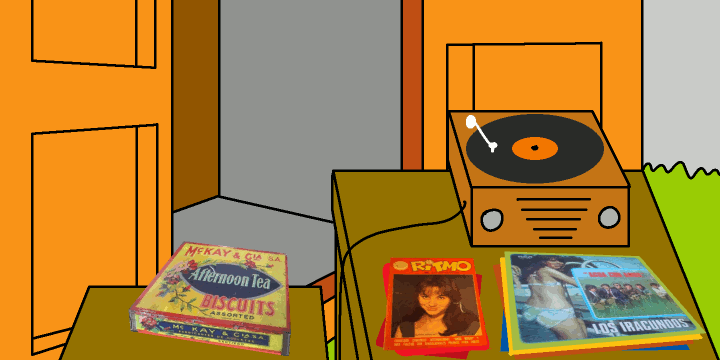#421: Record player - 2017-02-04

February 14, 1996. After 10 days of arduous work, María Sepúlveda's house was in a good state. The weed was rooted out, the roof repaired, the walls painted, the floor clean and waxed, and the trash taken out. The only thing that remained to be done was to clean the pool, but there was no time for that, as everyone, Rosa foremost, wanted to leave for the mountain as soon as possible.
María and her great-great-grandchildren decided to take a day of rest. At lunch there was horse mackerel with onions, tomatoes, peas and corn. Ice cream for dessert. After that, they took a nap.
At 17:00, María called her great-great-grandchildren, because she wanted to show them something that, while they were concentrated into repairing the house, had forgotten. Near a side of the house, there was a shipping container of orange color, labelled after NYK, a Japanese shipping company. María had bought that container during the early 80s, and she kept many valuable things there.
The container was closed with a lock that was already rusted. María had the key, but she couldn't open it. Pedro brought a hammer and gave it a single hit; the lock opened by itself. Then, they could open it.
The air inside the container was stale, and the smell of old that came from inside was pungent. The good thing was that there weren't any cobwebs. After waiting for it to air out, the first thing they did was to get an old record player that was kept there, alongside many vinyl records, mainly from the South American Nueva Ola of the sixties and seventies. When they plugged it to an extension cord, they found out that it still worked. The first record they played was the LP “Agua con Amor” by the Uruguayan band Los Iracundos.
- “ You don't have older music? ” - Pedro asked.
- “ I was never a fan of « música típica », which was what was listened the most around here during the 20s through the 40s. ”
- “ Música típica? ”
- “ Los Cuatro Huasos, Los Huasos Quincheros, Los Cuatro Cuartos, Silvia Infantas y los Cóndores... that kind of music. I thank to life for Violeta Parra, who stood up and changed everything. Yeah, it was during the 50s, the beginning of Chilean music as we know it now, including the « Nueva Ola », rock and roll, pop, boleros, ballads, Latin American fusion, etc. Before that, there was nothing but huasos. ”
- “ Wow... ”
- “ Luis Emilio liked cueca chilota, vals chilote, the Costillar, the Sirilla and everything that sounded like that. Actually, he was a fan of all things Chiloé island, and we always went there for vacations, though we never moved from Chillán. ”
- “ ... And you didn't like it... ”
- “ That's not quite correct, though I wasn't a fan either. However, I liked it when he brought me to know new places, when we ate different things, etc. I was always attracted by the magic of Southern Chile, though the music seemed antiquated to me. I used to dance to all these things anyway; nowadays I don't remember a single step. ”
- “ Good for you. At school they still try to teach us those folklore dances. I'd rather let those remain in their own times, when there was no other choice. ”
- “ There was no other choice, well said. Because, well, I can't imagine a world without rock. ”
- “ And without hip-hop, too. Really, there wasn't anything else to dance to? ”
- “ Well... Tango already existed, and classic music too, but we didn't listen to that much around here. By the way, hip-hop is a thing of this time only. AFAIK, it didn't exist in 1987, at least not here in Chile. ”
- “ I blame the military government, which isolated Chile from the world. ”
- “ Right. But let's not speak about that. I have other things to show you here. ”
Next to the record player there was a typewriter from the 30s, weighting scales, some clocks, a coffee grinder, a sewing machine, a small music box, a photo camera, a press, a clothes iron, some Danish butter cookie tins with various small objects, and several trunks that María decided not to open.
Behind those, a large piece of furniture, a library full of books. They had to turn it to the other side in order to access the books. And before that, they had to move all the objects that were in front of the library at the container... ”
